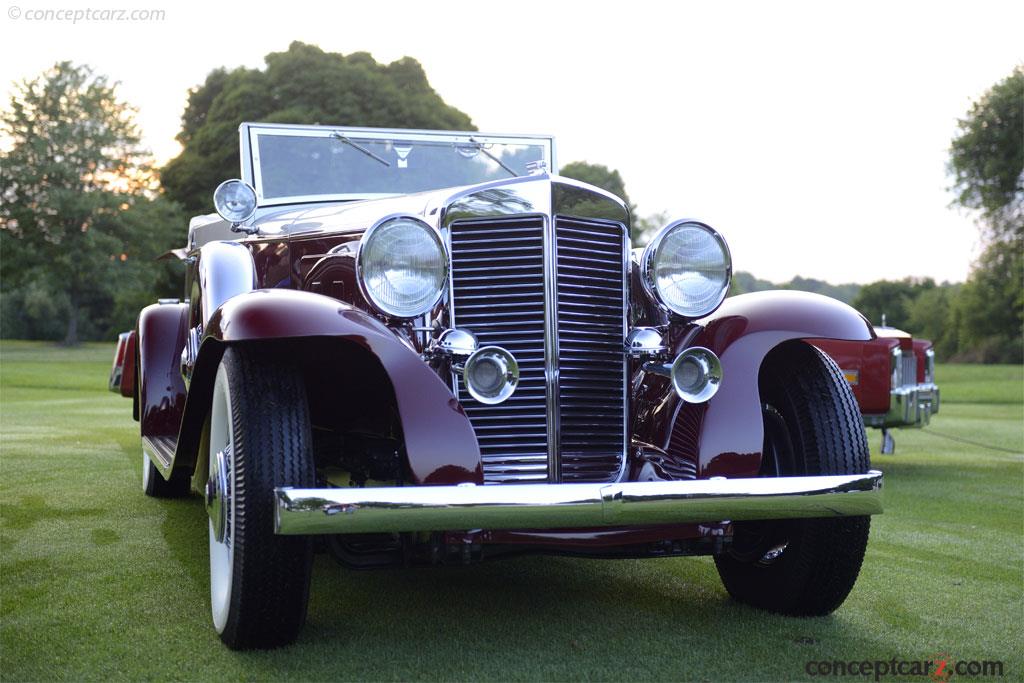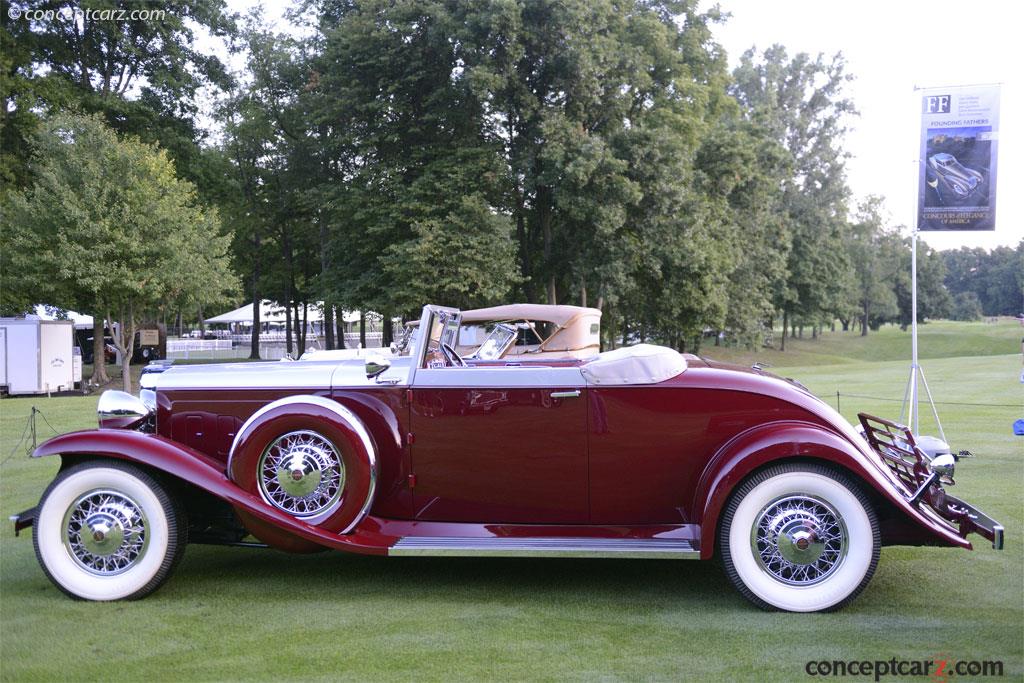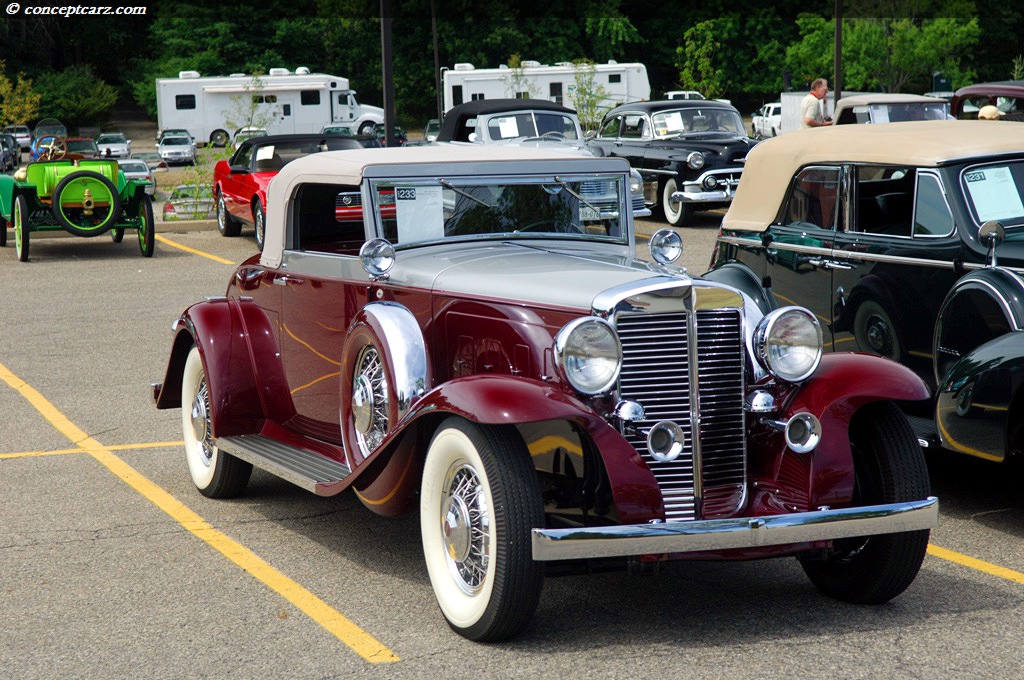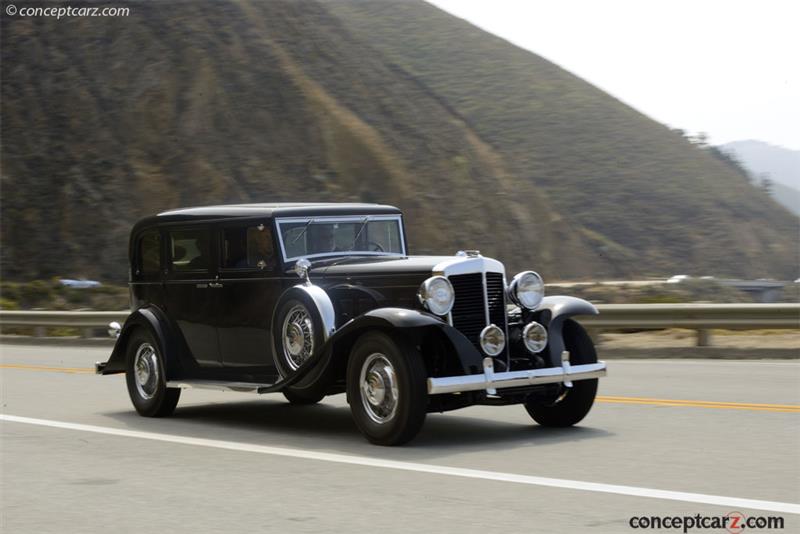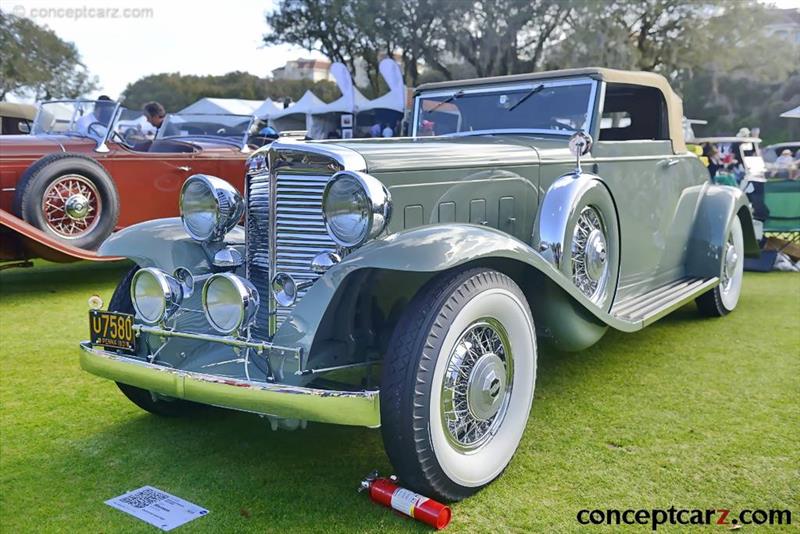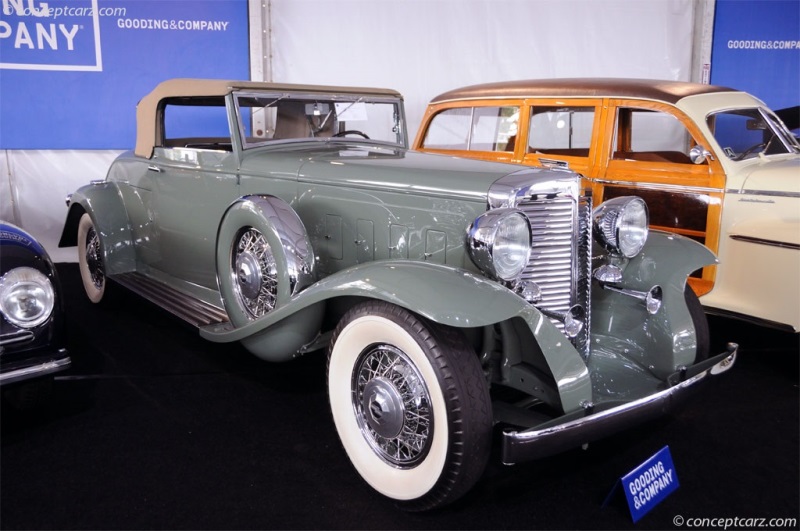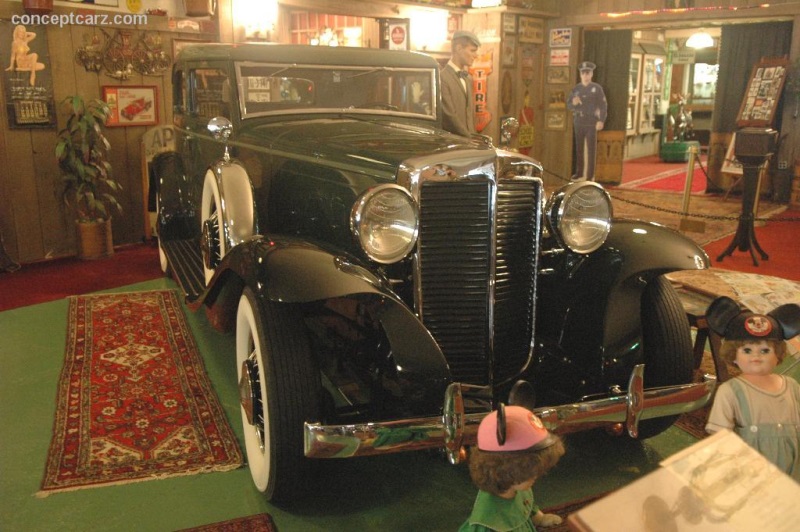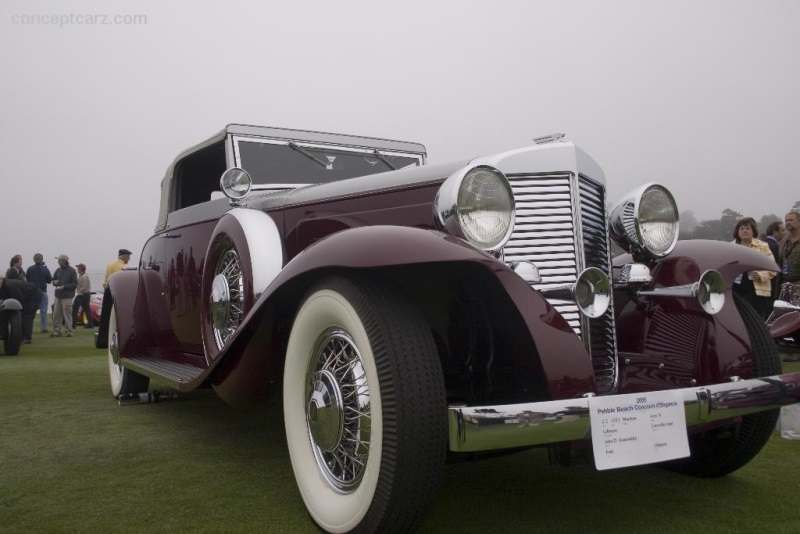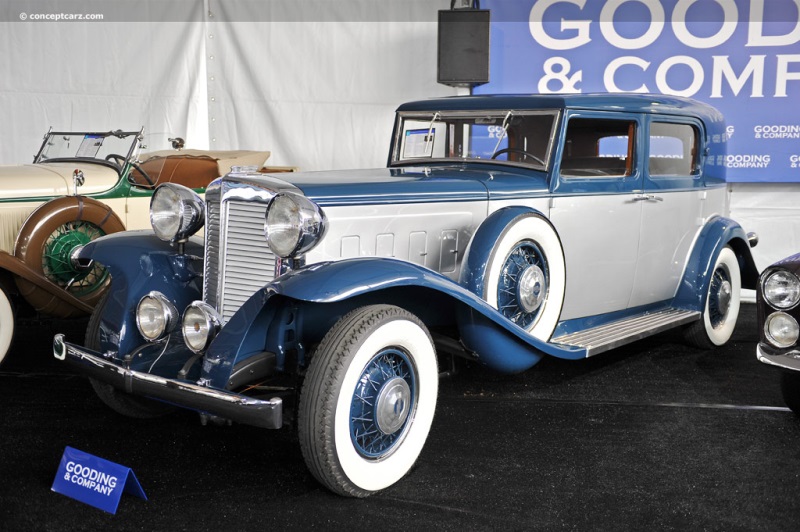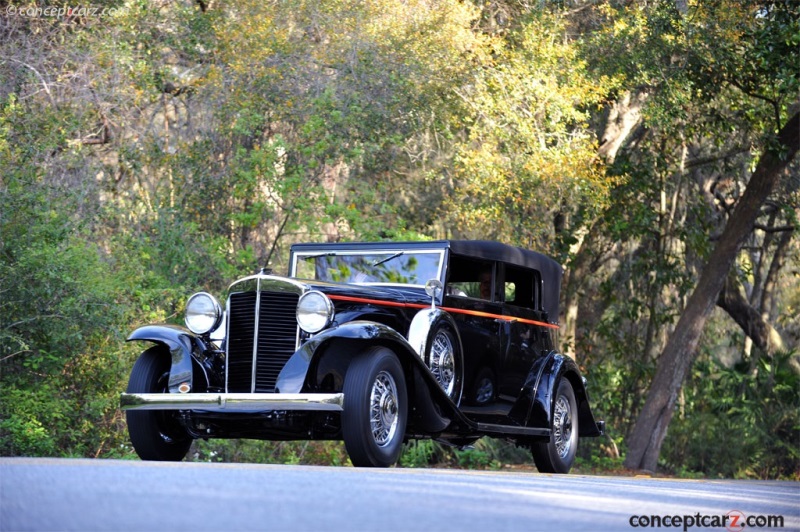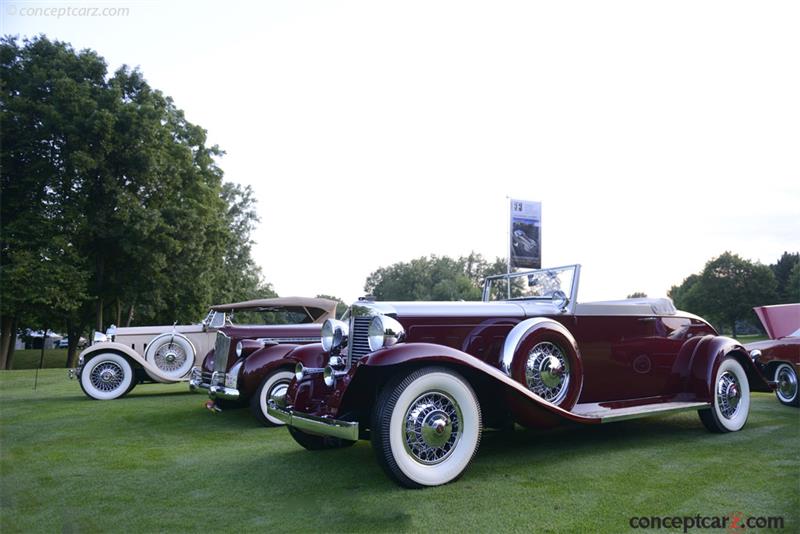Image credit: © conceptcarz.com (Reproduction Or reuse prohibited).
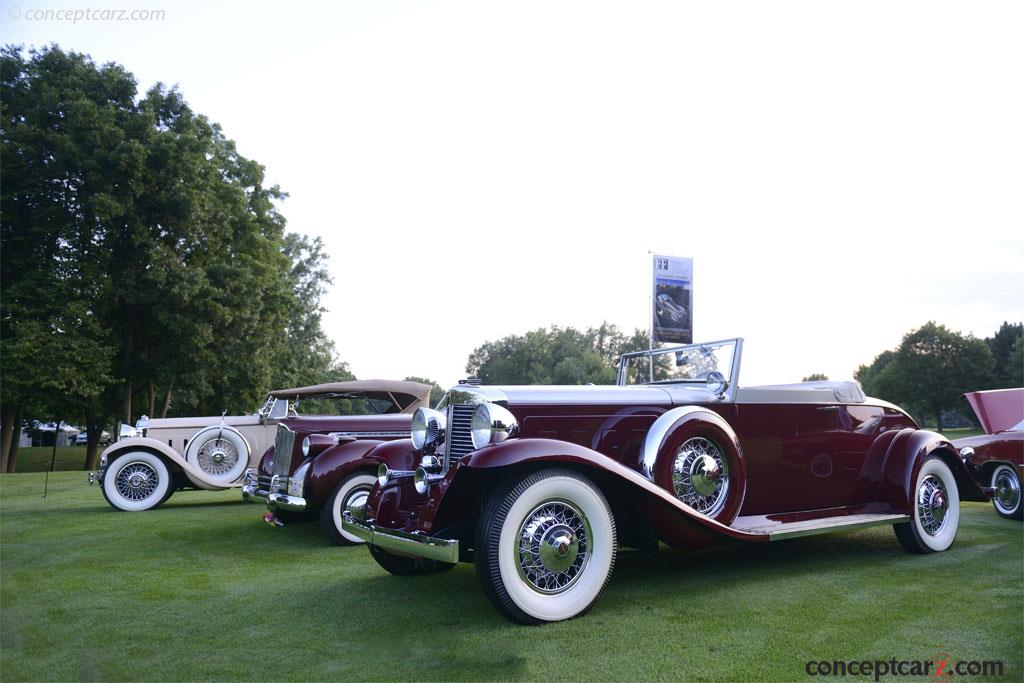
Marmon introduced their V-16 at the 1931 New York Auto Show. Howard C. Marmon had been developing a multi-cylinder airplane engine beginning in 1926, which eventually culminated in this 491 cubic inch 45-degree V-16 automobile engine. The engine is all aluminum with case-hardened cylinder sleeves, overhead valves, detachable cylinder heads with bronze valve seats, blade and fork connecting rods, a Stromberg duplex downdraft carburetor, and Delco electrical system. The 930-pound engine produces 200 horsepower giving the engine one of the highest power-to-weight ratios ever generated at that time.
Besides having a very modern engine design, the coachwork produced by LeBaron, from designs by Walter Dorwin Teague with influences from Ray Dietrich and Frank Hershey, was extraordinarily modern and unique. They were aerodynamically engineered to reduce wind resistance to a minimum, with a slanted radiator, windshield, and a curved roof line and shaped rear panel, the flow of air over the body was smooth with few pockets of drag-inducing turbulence.
The Depression hit Marmon very hard and the market for a $5,000 luxury car was very limited, to the degree that only about 390 V-16 Marmons were built between 1931 and 1933 when production ceased.
Besides having a very modern engine design, the coachwork produced by LeBaron, from designs by Walter Dorwin Teague with influences from Ray Dietrich and Frank Hershey, was extraordinarily modern and unique. They were aerodynamically engineered to reduce wind resistance to a minimum, with a slanted radiator, windshield, and a curved roof line and shaped rear panel, the flow of air over the body was smooth with few pockets of drag-inducing turbulence.
The Depression hit Marmon very hard and the market for a $5,000 luxury car was very limited, to the degree that only about 390 V-16 Marmons were built between 1931 and 1933 when production ceased.
In 1902, Howard Marmon was only 23 but had already constructed his first automobile. It was an advanced piece of machinery for the time, featuring overhead valves and air cooling. Nine years later, a Marmon was driven to a victory at the inaugural Indianapolis 500 race. The Indianapolis 500 race was much different in 1911 than it is today; instead of just taking three hours to complete, it took all day. The race tested the driver and car's stamina at full speeds for many, many hours. Completing the race was considered an accomplishment, but winning it was the ultimate achievement. Following on the heels of this success, the Marmon cars were driven to over 50 race victories in the following two years.
Marmon automobiles seemed to have to problems winning on the race track, but in the showrooms the cars were less successful. Marmon did offer a road-going version of its Indianapolis 500 Wasp, dubbed the Model 49, but at $5000, this was too high for most individuals.
The company's savior came in the form of World War I, when the engineering talents of the company were commissioned to build 5,000 Liberty aircraft engines. This gave Marmon financial stability.
After WWI, the company resumed production of its Model 34, a car that was introduced in 1916 and included extensive use of aluminum. Many items on this Model 34 were created from aluminum, including the transmission, rear axle, body, fenders, and radiator. Sales were disappointing and when the post-war recession began to show its ugly head, Marmon began feeling the financial pressure. In 1924, Howard's brother resigned the presidency and George M. Williams took over his duties. Williams saw a future in Marmon with a more affordable line of models that would attract more buyers and increase sales. The result of his vision was the Roosevelt Model powered by a straight eight-cylinder engine. The gamble proved to be accurate as sales increased greatly and the company was once again financially sound. By the close of the 1920s, Marmon was building more than 20,000 cars per year.
The financial security allowed Marmon to further pursue his engineering passion and to continue to carve a legacy in the automotive industry, by creating the Marmon Sixteen in 1931. The name 'Model 16' was appropriate as the car was powered by a state-of-the-art sixteen-cylinder, overhead valve engine that displaced nearly 500 cubic inches and produced 200 horsepower. The engine had all-aluminum construction which meant it was both lightweight and strong. Many other areas of the car were also built from aluminum, including many parts of the chassis. The power-to-weight ratio was unmatched by any other marque of the era and the Sixteen was able to achieve 100 mph with very little effort.
The Sixteen had only one flaw - when it was introduced. Cadillac had introduced their sixteen-cylinder car nearly two years before Marmon's was introduced. More importantly was The Great Depression, which was strangling the pockets of potential buyers. By 1933, Marmon found itself out of business.
This Marmon Sixteen Convertible Coupe is one of the few surviving examples in modern times. It has an elegant LeBaron coachbuilt body featuring the legendary LeBaron cowl tags. The design for the vehicle was penned by Walter Dorwin Teague Jr., a student at MIT at the time. His father, Walter Dorwin Teague Sr., had been given the project but had passed it along to his automotive enthusiast son.
This car has been treated to a comprehensive professional restoration that brought it back to better-than-new condition. It is finished in a two-tone paint scheme with a tan convertible top. It earned its CCCA Senior Award status in June 2002.
There were only 22 examples of the convertible coupe constructed with only eight remaining in modern times. Six are in private collections, one is in a museum in the Netherlands, and one is in the process of being restored.
This 1931 Marmon Sixteen Convertible Coupe was offered for sale at the 2007 RM Auctions held at Meadow Brook where it was offered without reserve and estimated to sell for $400,000 - $500,000. It is powered by an overhead valve V16 engine mounted at a 45-degree angle. There is a three-speed manual gearbox and four-wheel servo-assisted mechanical drum brakes. At the auction, the car was sold for an impressive $726,000.By Daniel Vaughan | Aug 2007
Marmon automobiles seemed to have to problems winning on the race track, but in the showrooms the cars were less successful. Marmon did offer a road-going version of its Indianapolis 500 Wasp, dubbed the Model 49, but at $5000, this was too high for most individuals.
The company's savior came in the form of World War I, when the engineering talents of the company were commissioned to build 5,000 Liberty aircraft engines. This gave Marmon financial stability.
After WWI, the company resumed production of its Model 34, a car that was introduced in 1916 and included extensive use of aluminum. Many items on this Model 34 were created from aluminum, including the transmission, rear axle, body, fenders, and radiator. Sales were disappointing and when the post-war recession began to show its ugly head, Marmon began feeling the financial pressure. In 1924, Howard's brother resigned the presidency and George M. Williams took over his duties. Williams saw a future in Marmon with a more affordable line of models that would attract more buyers and increase sales. The result of his vision was the Roosevelt Model powered by a straight eight-cylinder engine. The gamble proved to be accurate as sales increased greatly and the company was once again financially sound. By the close of the 1920s, Marmon was building more than 20,000 cars per year.
The financial security allowed Marmon to further pursue his engineering passion and to continue to carve a legacy in the automotive industry, by creating the Marmon Sixteen in 1931. The name 'Model 16' was appropriate as the car was powered by a state-of-the-art sixteen-cylinder, overhead valve engine that displaced nearly 500 cubic inches and produced 200 horsepower. The engine had all-aluminum construction which meant it was both lightweight and strong. Many other areas of the car were also built from aluminum, including many parts of the chassis. The power-to-weight ratio was unmatched by any other marque of the era and the Sixteen was able to achieve 100 mph with very little effort.
The Sixteen had only one flaw - when it was introduced. Cadillac had introduced their sixteen-cylinder car nearly two years before Marmon's was introduced. More importantly was The Great Depression, which was strangling the pockets of potential buyers. By 1933, Marmon found itself out of business.
This Marmon Sixteen Convertible Coupe is one of the few surviving examples in modern times. It has an elegant LeBaron coachbuilt body featuring the legendary LeBaron cowl tags. The design for the vehicle was penned by Walter Dorwin Teague Jr., a student at MIT at the time. His father, Walter Dorwin Teague Sr., had been given the project but had passed it along to his automotive enthusiast son.
This car has been treated to a comprehensive professional restoration that brought it back to better-than-new condition. It is finished in a two-tone paint scheme with a tan convertible top. It earned its CCCA Senior Award status in June 2002.
There were only 22 examples of the convertible coupe constructed with only eight remaining in modern times. Six are in private collections, one is in a museum in the Netherlands, and one is in the process of being restored.
This 1931 Marmon Sixteen Convertible Coupe was offered for sale at the 2007 RM Auctions held at Meadow Brook where it was offered without reserve and estimated to sell for $400,000 - $500,000. It is powered by an overhead valve V16 engine mounted at a 45-degree angle. There is a three-speed manual gearbox and four-wheel servo-assisted mechanical drum brakes. At the auction, the car was sold for an impressive $726,000.By Daniel Vaughan | Aug 2007
2015 RM Sotheby's : The Andrews Collection
Sale Price :
USD $1,320,000
2007 Vintage Motor Car Auction at Meadow Brook Hall
Pre-Auction Estimates :
USD $400,000-USD $500,000
Sale Price :
USD $726,000
2005 Vintage Motor Cars in Arizona
Pre-Auction Estimates :
USD $400,000-USD $500,000
Sale Price :
USD $456,500
1931 Marmon Model 16 Auction Sales
Recent Sales of the Marmon Model 16
(Data based on Model Year 1931 sales)
| 1931 Marmon Sixteen Convertible Sedan by LeBaron Chassis#: 16 145 678 Sold for USD$335,000 2024 RM Sothebys : Arizona |   |
| 1931 Marmon Sixteen Convertible Sedan by LeBaron Chassis#: 16-145-678 Sold for USD$330,000 2022 RM Sothebys : The Hershey Auction |   |
| 1931 Marmon Sixteen Limousine Chassis#: 16147602 Sold for USD$451,000 2022 Mecum : Monterey |   |
| 1931 Marmon Sixteen Convertible Sedan Chassis#: 16145666 Sold for USD$550,000 2022 Mecum : Monterey |   |
| 1931 Marmon Sixteen Convertible Coupe Chassis#: 16144722 Sold for USD$1,182,500 2022 Mecum : Monterey |   |
| 1931 Marmon Sixteen Coupe by LeBaron Chassis#: 16 141 675 Sold for USD$550,000 2019 RM Sothebys : Hershey |   |
| 1931 Marmon Sixteen Convertible Sedan by LeBaron Chassis#: 16 149 554 Sold for USD$170,800 2019 RM Sothebys : The Guyton Collection | |
| 1931 Marmon Sixteen Coupe by LeBaron Chassis#: 16 141 694 Sold for USD$1,050,000 2018 RM Sothebys : Amelia Island |   |
| 1931 Marmon Sixteen Convertible Coupe Chassis#: 16144652 Sold for USD$1,210,000 2016 Gooding & Company : Pebble Beach |  |
| 1931 Marmon Sixteen Convertible Sedan by LeBaron Chassis#: 16 145 593 Sold for USD$632,500 2016 RM Sothebys : Amelia Island |   |
| A Pair of Marmon Sixteen Chassis, c. 1931 Chassis#: 16 140 942 Sold for USD$66,000 2015 RM Sotheby's : The Andrews Collection | |
| 1931 Marmon Sixteen Convertible Coupe by LeBaron Chassis#: 16 144 705 Sold for USD$1,320,000 2015 RM Sotheby's : The Andrews Collection |   |
| 1931 MARMON HOT ROD ROADSTER Chassis#: MARMON16654 Sold for USD$275,000 2014 Barrett-Jackson's 43RD Annual Scottsdale Auction | |
| 1931 Marmon Sixteen Coupe Chassis#: 16141694 Sold for USD$687,500 2011 Automobiles of Arizona by RM Auctions |   |
| 1931 Marmon Sixteen Limousine Chassis#: 16147602 Sold for USD$346,500 2010 RM Auctions - Vintage Motor Cars of Meadow Brook |   |
| 1931 Marmon Model 16 Chassis#: 16144722 Sold for USD$517,000 2009 Vintage Motor Cars of Hershey by RM Auctions |   |
| 1931 Marmon Sixteen Limousine Sold for USD$374,000 2007 Vintage Motor Car Auction at Meadow Brook Hall | |
| 1931 Marmon Model 16 Sold for USD$726,000 2007 Vintage Motor Car Auction at Meadow Brook Hall |   |
| 1931 Marmon Sixteen Convertible Coupe Chassis#: 16144705 Sold for USD$456,500 2005 Vintage Motor Cars in Arizona |   |
| 1931 Marmon Sixteen Convertible Sedan Chassis#: 16860 Sold for USD$291,500 2004 S. Ray Miller Collection |   |
Marmon Model 16s That Failed To Sell At Auction
1931 Marmon Model 16's that have appeared at auction but did not sell.
| Vehicle | Chassis | Event | High Bid | Est. Low | Est. High |
|---|---|---|---|---|---|
| 1931 Marmon 16 | 2018 Mecum : Denver | $40,000 | |||
| 1931 Marmon Sixteen Close-Coupled Sedan | 149630 | 2018 Worldwide Auctioneers : Scottsdale | $200,000 | $300,000 | |
| 1931 Marmon Sixteen Convertible Coupe | 16-144-722 | 2012 RMAutomobiles of Arizona | $450,000 | $475,000 | $650,000 |
| 1931 Marmon 16 | 16-149-752 | 2011 Branson Collector Car Auction Oct 22, 2011 | $165,000 | ||
| 1931 Marmon Sixteen Five-Passenger Sedan | 149 752 | 2011 Gooding and Company Pebble Beach Auctions | $225,000 | $275,000 | |
| 1931 MARMON UNKNOWN 5 PASSENGER SEDAN | 2001 Kruse Auction Scottsdale Arizona | $89,000 |
Vehicles With Comparable Market Values
Similar sales to the $576,090 range.
| 1902 Packard Model G Rear Entrance Tonneau Sold for $572,000 2024 RM Sothebys : Hershey | |
| 1932 Chrysler CL Imperial Convertible Roadster by LeBaron Chassis#:7803491 Sold for $572,000 2024 RM Sothebys : Hershey | |
| 2006 Ford GT Chassis#:1FAFP90S16Y400600 Sold for $577,000 2024 Broad Arrow : Monterey |   |
| 1973 Porsche 911 Carrera RS 2.7 Chassis#:9113601291 Sold for $577,000 2024 Gooding & Company : Pebble Beach | |
| 1968 Serenissima GT Coachwork by Ghia Chassis#:GT001 Sold for $580,000 2024 Gooding & Company : Pebble Beach | |
| 1937 Bugatti Type 57 Stelvio Coachwork by Gangloff Chassis#:57600 Sold for $577,000 2024 Gooding & Company : Pebble Beach |   |
| 1971 Ferrari 365 GTB/4 Daytona Berlinetta by Scaglietti Chassis#:14071 Sold for $579,405 2024 RM Sothebys : Paris | |
| 1971 PLYMOUTH HEMI CUDA Chassis#:BS23R1B347550 Sold for $577,500 2024 Barrett-Jackson : Scottsdale AZ | |
| 1935 BREWSTER COUPE ROADSTER Chassis#:181117853 Sold for $577,000 2023 Gooding & Company : Estate of Mark Smith Auction |   |
| 1962 Chrysler Ghia L6.4 Chassis#:0305 Sold for $577,000 2023 Bonhams : Scottsdale Auction |   |
| 2018 PORSCHE 911 GT2 RS Chassis#:WP0AE2A92JS186077 Sold for $577,500 2023 Barrett-Jackson : Scottsdale, Az. | |
| 1962 CHEVROLET CORVETTE 327/300 CONVERTIBLE Chassis#:20867S107385 Sold for $572,000 2023 Barrett-Jackson : Scottsdale, Az. | |
| 2006 FORD GT Chassis#:1FAFP90S36Y400663 Sold for $577,500 2023 Barrett-Jackson : Scottsdale, Az. |   |
| 1953 KINDIG CF1 BARRETT-JACKSON EDITION CUSTOM ROADSTER Chassis#:UTR07088 Sold for $572,000 2023 Barrett-Jackson : Scottsdale, Az. | |
| 1936 Bugatti Type 57 Binder Coupe Sold for $577,500 2023 Mecum : Kissimmee | |
| 1970 Pontiac GTO Judge Ram Air IV Convertible Sold for $572,000 2023 Mecum : Kissimmee | |
| 2021 McLaren 765LT Sold for $572,000 2023 Mecum : Kissimmee | |
| 1966 FERRARI 330 GT 2+2 SERIES II Chassis#:08325 Sold for $577,000 2022 Gooding & Company : Pebble Beach |   |
| 1939 Bugatti Type 57C Stelvio by Gangloff Chassis#:57769 Sold for $577,000 2022 RM Sothebys : Monterey |   |
| 1967 Ferrari 330 GTC Chassis#:9955 Sold for $577,500 2022 Mecum : Monterey |   |
1931 Marmon Model 16
• Additional valuation insight and sales data• History
• Specifications
• Image gallery
• Other Marmon Model 16 model years
